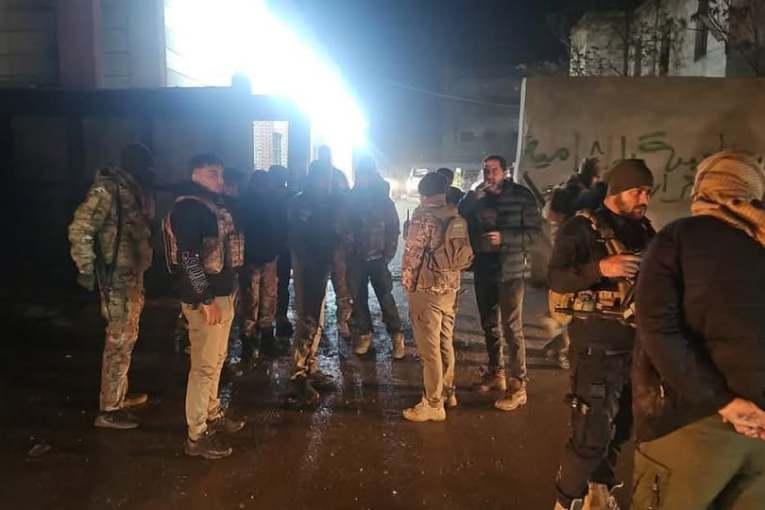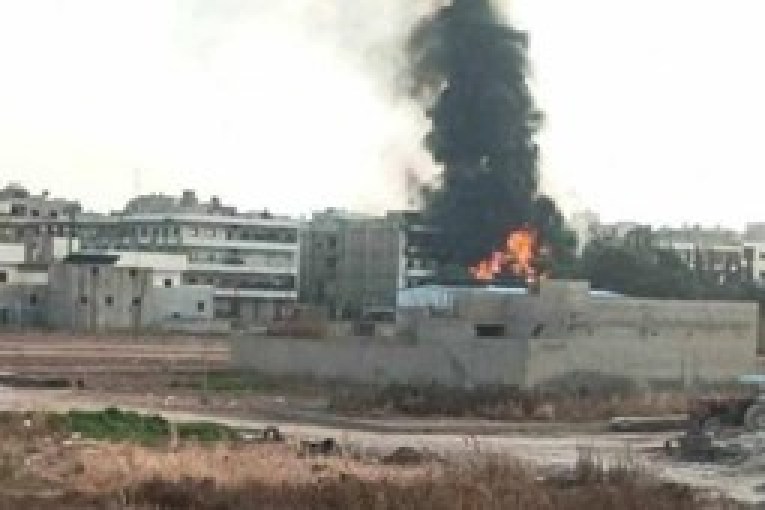
In two separate incidents, the image of former Iraqi President Saddam Hussein was present in Afrin, the image was raised after the occupation of the city on car windows, and the topic is about the symbolism of Saddam’s name and the provoking of Kurdish sensitivity, as it is directly related to the genocide against the Kurds, and therefore the image is intended to provoke the Kurds , and inciting their memories about the massacres, thus making it a hidden message.
Saddam’s picture in Afrin
On the front of a house in the old Afrin neighborhood, close to Rajo Street, a poster with two pictures of Zahran Alloush and Saddam Hussein was raised and written on the poster “The Army of Islam Remain, God is Greatest.” Jaish Al-Islam had seized the house and made it its headquarters, while Yasser Dullwan, head of the Political Bureau of Jaish Al-Islam, denied the relationship of his organization with the building., and he said: We immediately removed the image that was placed on one of the houses in the city. ”He pointed out that the house is inhabited by a person from Deir al-Zour who loves Jaish Al-Islam and is not affiliated with it. And the accident raises questions about the purpose and according to the evidences clearly explained.
The second incident is the sudden emergence of a military platoon in Afrin in the name of “Saddam Hussein Brigade”, and sources say that the platoon members are former mercenaries in ISIS and with the collapse of ISIS they fled to the areas of Turkish influence, gathered in Jabal al-Zawiya and organized themselves under the guide of Turkish intelligence. Recently, some elements of “Ahrar al-Sharqiya” were withdrawn in Afrin and replaced with a battalion of what is known as the “Saddam Hussein” battalion.
The platoon is based near the main market in ancient Afrin, and has an estimated strength of 400, most of whom were former Iraqi emirs and security officials of ISIS, some of whom wear Afghan and others camouflaged military uniforms. The leading members were former Iraqi intelligence elements, some of whom fought with the Turkish forces within the “Euphrates Shield” factions, as they possess a high combat experience, and the Turkish intelligence provided them with advanced weapons, while ideologically characterized by extremism .
Anfal and Halabja
During the Iranian war, the Iraqi army launched the Anfal campaign against the Kurds, which included eight stages according to the geographical distribution. The first phase began on 22/2/1988 and the eighth phase ended on 9/9/1988. More than 182,000 Kurds, men, women and children were martyred. The leaders of operations and massacres were Defense Minster Adnan Khairallah and Ali Hassan Al-Majeed, nicknamed “Chemical Ali” and Nizar Al-Khazraji.
The third stage was the worst and the Kurds call it the black Anfal, for the atrocity of operations and massacres, and it started on 7/4/1988 which means the day corresponding to the birth of the Baath Party, and destroyed about 500 villages completely. On April 14 1988, Iraqi forces buried families and individuals in mass graves while they were alive. This day was the commemoration of the Anfal massacres.
As for the Halabja massacre, it took place on 16/3/1988, in which the chemical weapon (mustard gas and cyanide) was used, and 5,500 people of different age groups were martyred. Ali Hassan al-Majid, who ordered the bombing, did not show any remorse for the massacre and said that he acted out of his concern for the security of Iraq. Foreign Policy magazine (2013) said that Baghdad relied on American intelligence information about an Iranian preparedness to attack, after its withdrawal from the region.
Kurdish and Arab Shiites
In the file of the Faili Kurds (the Shiite Kurds), many tragedies occurred. On 4/4/1980 thousands of Faili families were pushed to the Iranian border, many died outdoors, and the youth were arrested, and during the war with Iran, the Faili youth were taken to the “forbidden lands” which are mine fields on the border to be exploded by them, opening the way for the Iraqi army. On 7/4/1980 900 Faili Kurdish merchants were invited to a meeting in Baghdad, opened by Taha Yassin Ramadan, with a racist speech, and immediately after the meeting, the merchants were deported to the Iranian borders, and on 7/5/1980 Decree 666 was issued to drop the Iraqi nationality for about half a million Kurdish Faili, stripped of their property and homes, thousands were thrown into prisons, hundreds of thousands were transferred to custody in several governorates, and between 1983-1986 invasive chemical experiments were carried out in a number of prisons holding about 15,000 Faili prisoners,
One of the unforgettable scenes is the writing of the slogan “No Shiites after today” on the Iraqi tanks that stormed the Shiite cities to suppress the popular uprising after the withdrawal of the Iraqi army from Kuwait and the collapse of the economic situation and the destruction of the infrastructure. The uprising began on 2/3/1991, with an Iraqi officer firing withdrawing from Kuwait shots on the image of Saddam in the city of Basra, and the people subsequently demonstrated, calling for slogans opposing Saddam and the war. The events lasted about two weeks, killing 300,000 people, displacing two million, and carrying out mass executions, burying people alive, and the operation was led by General Hussein Kamel and Taha Yassin Ramadan.
The Iraq wars and the Arab contradiction towards them
Saddam’s history is not far away, and there are no indications of an Arab consensus on him being a figure who formed a universal Arab symbole, and it is known that the Arab reality for decades is marked by division and differences, and talk about the personality of the former Iraqi president is shrouded in controversy and many Arabs themselves differ on it.
Iraq until the fall of the regime in it was ruled by the Baath Party, known for its nationalist slogans, but when it deals with history and religion, it glorifies the Umayyad and Umayyad states and thus adopts the Sunni trend. During the Saddam era, Syrian-Iraqi relations reached their worst cases, which were marked by media defamation campaigns, and Iraq was a haven for many Syrian opponents.
Talking about the symbolism of Saddam Hussein calls for a return to history, and how he came to power. He assumed the presidency of Iraq after the coup against the former Iraqi President Ahmed Hassan al-Bakr on 16/7/1979 at a time of great sensitivity. The Syrian-Iraqi talks had reached a stage to declare unity between the two countries, overthrow the regime of Shah Muhammad Reza Pahlavi in Iran and announce the victory of Khomeini’s revolution in Iran and the adoption of the Islamic regime on 11/2/1979. During the years of Saddam Hussein’s rule, Iraq suffered the ravages of three major wars and a severe economic blockade.
The first Gulf War (the war on Iran) came with the Baghdad Declaration to cancel the 1975 Algiers Agreement. The war started on 22/9/1980, and it was against Iran and the Arab countries supported Iraq throughout the war years. The levels of support with funding and armaments as well as with fighters increased, and the war ended 8/28/1988 leaving more than a million dead and nearly two million injured. And covered the headlines of nationalism and sectarianism, and throughout the war years the most prominent slogans were that it was the war of the Arabs against the Persian Magi, which is the Qadisiyah of the Arabs, and the protection of the eastern gate of the Arab world. Iraq’s relations with Iran under the reign of Shah Muhammad Reza Pahlavi did not rise to ideal friendship, but it was not characterized by hostility.
The Iraqi army launched a war against Kuwait on 2/8/1990, and most Arab countries joined the International Alliance for the Liberation of Kuwait (Operation Desert Shield) that started on 17/1/1991 until 28/2/1991 and that was the second Gulf War and resulted in 100,000 dead And 75 thousand wounded, and on the second day of the war, Iraqi missiles targeted Israel with 39 missiles, and after the bombing, Israel received US $ 10 billion in defense aid.
The third war started when the international coalition launched the war on Iraq on 3/23/2003, the Arab countries did not support the government and people of Iraq, and the occupation of Iraq continued until 18/12/2011.
At the beginning of Saddam’s era, Iraq started building the “Tammuz” nuclear reactor, and Israel implemented the “Opera” operation on June 6, 1981 and destroyed the reactor project. Iraq also developed models of Scud missiles, and its range increased at the expense of the destroyed charge, but the project was not at a level of a threat, however, after 9/11/2001 the United States had placed Iraq and Afghanistan at the top of the list of countries targeted for terrorism charges, and then modified to give priority to the Afghanistan war, and then Iraq.
Saddam Hussein was sentenced to death in connection with the Dujail case, the Shiite town in which 148 people were killed, and the sentence was executed on December 30, 2006 on the morning of Eid al-Adha.
It is possible to understand the symbolism and the intended message by raising the image of Saddam, who killed Kurds and Shiites, the oppression of the Sunnis, and the rule of Iraq with iron and fire. Saddam’s character was treated as a model for the Arab tribal, and at the same time as a Sunni sectarian project against the Shiite Iranian situation, and in his staying at the head of government he relied on the role of security and military institutions, especially the Republican Guard.
According to the totality of historical data, it is possible to understand the aspect of the intended symbolism of evoking Saddam’s character in a region occupied by Turkey, and it relies on elements with sectarian backgrounds irrespective of their religious commitment. The issue is related to investing the factors of difference and exaggerating them to incite more sedition and fuel it. It is not excluded in this, especially since it, with its intervention since the beginning of the crisis, played an important role in transforming it into a sectarian difference in order to facilitate its leadership.
Walat Afrini – Afrin Post
The article expresses the opinion of its author






